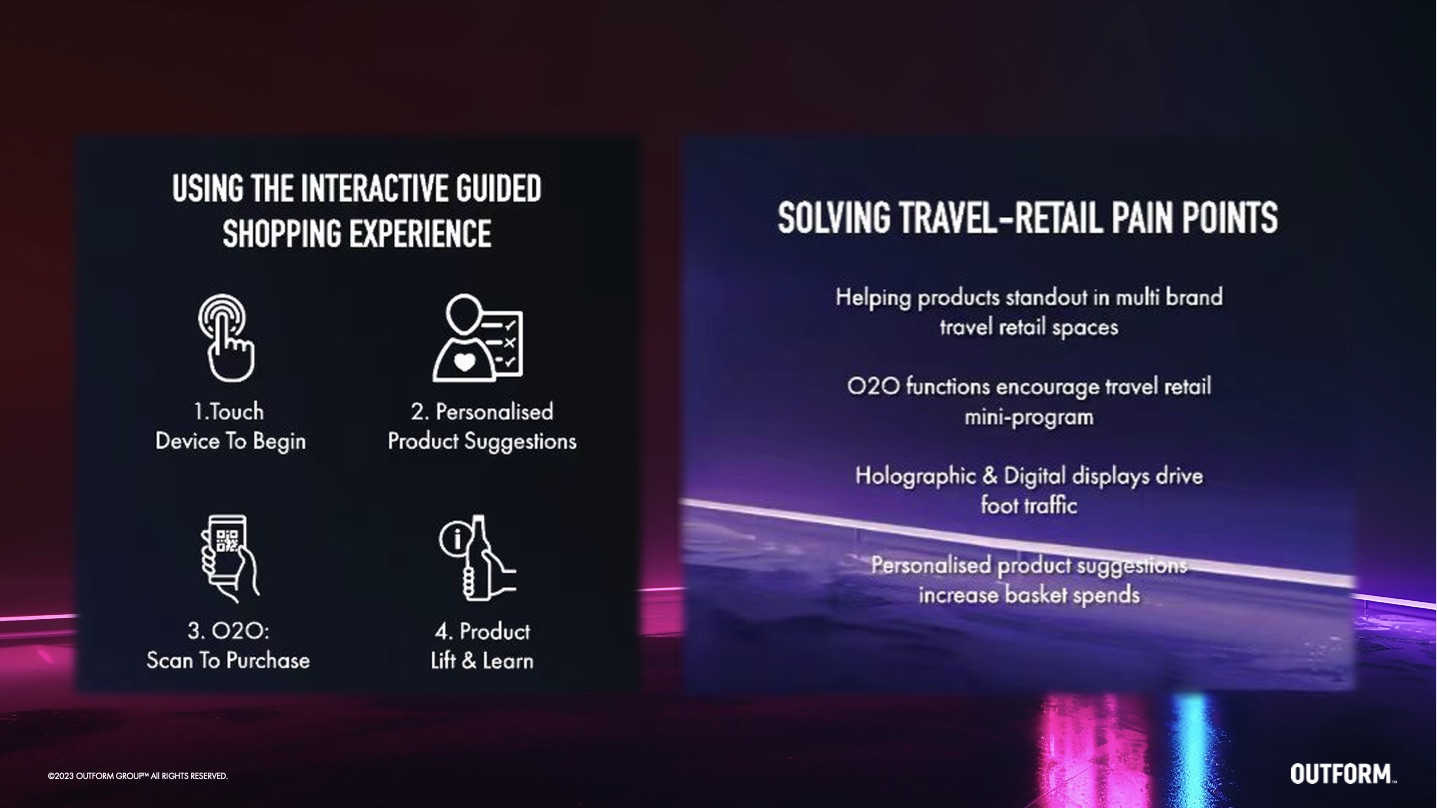Introduction: In this exclusive interview, Outform APAC Sales Director Paul Burke speaks to The Moodie Davitt Report Asia Pacific Content Strategist Lara Netherlands about the company’s progress and its aspirations in travel retail.
The global retail agency specialises in designing and manufacturing interactive, innovative travel retail displays and experiences.

Formed in 2003, Outform has gained a global reputation and presence in areas ranging from display design to technology, digital content and retail marketing. Its global footprint currently spans six countries, including the USA, UK, Netherlands, Poland, Israel and China. In China alone, the group is established in four locations – Shenzhen, Shanghai, Jiaxing and Beijing – and boasts over 90 employees, or ‘Outformers’.


Burke takes us on a journey of innovative technologies and interactive product displays and tells us why travel retail offers a unique opportunity for brands to bring Gen Z shoppers back into the physical store.
How would you describe Outform’s core values and DNA?
Innovation. Ariel Haroush [Outform Founder and CEO] has sought to create innovative, digital retail solutions in the industry which, in many ways, hasn’t changed much in the last 50 years. At Outform, we seek to continuously innovate and rethink everything – from whole phy-gital stores to items as ubiquitous as the digital mannequin.

‘Together we shape the future of retail’ is a company mission statement. Broadly speaking, how does the company encompass that in the way it works with brands and retailers?
COVID changed the way consumers travel and shop. It also shone a light on why forward-thinking and continued innovation in a rapidly changing market is necessary. We know the role of stores has changed – from being simply a space to buy things, to a place of experience, brand building and social sharing. We help brands future-proof themselves to transition into more resilient spaces.
You exhibited within the i.lab at the TFWA Asia Pacific Exhibition. Tell us about the company’s presence and aspirations in travel retail.
In 2024, especially within the Asia Pacific region, we see travel retail as a unique opportunity for brands. China’s Generation Z, which will become the largest travelling consumer group by 2030, primarily shops online. An airport represents a place to captivate their attention in a physical store.
We specialise in designing localised, scannable, digital displays that help retailers capture this group of mobile natives’ attention, driving brand awareness and basket spends.

You unveiled some impressive innovations in terms of the latest technological developments. Could you tell us about them and share your thoughts on the transformative impact these technologies could have on the channel?
In an age where data collection is critical to commercial success, we create displays which not only stand out but also give travel retailers and brands access to a platform which enables them to reconnect with shoppers even after they have left the airport. This is especially effective for brands with their own travel retail WeChat Mini Program. For instance, by having the shopper’s details you can send them a coupon for their return trip, encouraging increased spend per journey and fostering long-term brand loyalty.

What was the reaction from brands and retailers at the TFWA Asia Pacific Exhibition?
People were amazed at the hologram. Many expressed the need for more interactivity in travel retail as core shopper demographics shift, forcing them to rethink their displays.

We held an activation for alcohol travel retailers, but many brands from different verticals have been in touch for future cooperation – particularly those in the categories of beauty and small leathergoods.
Outform places noteworthy focus on Generation Z shoppers. What do you believe are the essential strategies for attracting younger consumers into travel retail stores?
Interactivity, social-sharing capabilities and customisation are key. Generation Z is 70% more likely to buy something they can put their own spin on.

One of the questions you posed at TFWA was how to future-proof travel retail. It is a simple question that requires a complex answer. How do you do that?

Consider this perspective: Instead of limiting their impact to a single airport encounter, it’s crucial for retailers to envision ongoing engagement with travellers. For example, incorporating socially shareable elements or offering customisable items provides a meaningful avenue to reconnect with consumers during their future travels. This macro approach to driving sales in travel retail is essential for sustained success.

You’ve enjoyed a stellar career in retail having held senior roles at prominent companies such as Adidas, Oakley, Galeries Lafayette (where you served as China CEO) along with a tenure at Dufry (now Avolta) in travel retail. Tell us about that journey and how you came to be working with Outform having culminated your own consultancy in Shanghai in 2016. What drew you to the company?
My journey in Asia began back in 2001 when I moved to Taiwan with a British company, where I spent six years. Thereafter, I was recruited by Adidas and spent a couple of years in Hong Kong, after which I relocated to Japan.
I was then headhunted by Oakley and moved to China in 2011, where I held the position of APAC Sales Director. During this period, Luxottica Group/ EssilorLuxottica acquired Oakley and opted to integrate it into their own stores, effectively closing Oakley’s standalone retail outlets.
I was lucky enough to meet people from Galeries Lafayette and was offered the chance to be their CEO in Beijing. This was a great experience which taught me about department store management. When the opportunity to work with Dufry presented itself, I recognised that my extensive experience with multiple brands would be invaluable in navigating the dynamic environment of airport retail.


I eventually made the decision to launch my own consultancy, specialising in assisting international brands to enter the Chinese market. Since then, I’ve collaborated with various companies to successfully achieve this goal.
As you may have noticed, I am a bricks-and-mortar retailer so what drew me to Outform was the opportunity to work with these brands on innovative solutions aimed at revitalising foot traffic and customer engagement in physical stores through interactive and digital technologies.

Outform offers very cool technological initiatives, which I know can drive traffic, increase conversion rate and enhance the customer experience. Particularly in airports where passengers may have limited shopping time, leveraging our cutting-edge technology can streamline the shopping process and directly contribute to increased sales.
Can you give some examples of standout success stories in how Outform has transformed shopping behaviour across various retail channels?
The Titleist ‘Digital Table’ was designed to drive sales for their golf ball lines. It has 3D content and lift & learn features, which increased product sales by over +30% according to Titleist Senior Retail Marketing Manager Fredrik Sundstrom. This table is a pilot test in the company’s Gangnam store based in South Korea and will be rolled out across Asia Pacific during 2024.
Then there’s the H&M ‘Social Fitting Room’, designed to supercharge social sharing from its new Barcelona flagship store. Mission accomplished – in just three short months livestreaming from this space hit 11 million views on TikTok; a very rare milestone for an offline retail activation.


Finally, what’s your overarching message to the travel retail community in terms of shaping the future of the business?
By 2050, Chinese shoppers will become the largest group of travelling consumers in the world. Building brand recognition with this demographic now, through localised, experiential activations, will future-proof your brand for years to come. ✈️


















